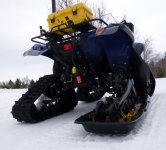ArlyA
Super Star Member
- Joined
- Mar 18, 2016
- Messages
- 12,056
- Tractor
- Outlander max 1000 6x6, Ego lawn mower
We have pods (you might call tracks) on a work ATV with shielded bearings from a company called Cosmo. Just a few years ago they called themselves Camoplast. These pods have many bearings in each unit, so to keep there cost low, they used less costly shielded ones in its idlers. In there 3rd year of use with us, we started loosing these bearings and as you might guess, they are not grease-able. We still have them today and replace bearings in them on a regular bases. By there 5th year with us, we had exceeded the original cost of these fine pods in repairs due to these poorly sealed bearings...... Saving $$ on seals is not a good investment in my amateur book of mechanics.
Attachments
Last edited:

